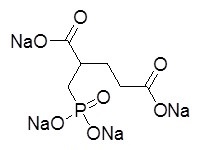All AbMole products are for research use only, cannot be used for human consumption.

In vitro: 2-PMPA (PMPA tetrasodium salt) is a potent and selective inhibitor of GCPII, an enzyme which catabolizes the abundant neuropeptide N-acetyl-aspartyl-glutamate (NAAG) to N-acetylaspartate (NAA) and glutamate. 2-PMPA demonstrates robust efficacy in numerous animal models of neurological disease. 2-PMPA is a highly polar compound with multiple negative charges causing significant challenges for analysis in biological matrices.
In vivo: Intraperitoneal administration of 100 mg/kg 2-PMPA results in maximum concentration in plasma of 275 μg/mL at 0.25 h. The half-life, area under the curve, apparent clearance, and volume of distribution are 0.64 h, 210 μg×h/mL, 7.93 mL/min/kg, and 0.44 L/kg, respectively. 2-PMPA at 250 mg/kg, in an anesthetized mouse, after an initial rise, produces a rapid decline and a striking attenuation in BOLD signals in gray matter. The signature of 2-PMPA on brain T2* signals in gray matter at both 167 and 250 mg/kg includes a significant initial rise lasting several minutes.
CAS#: 173039-10-6(free base)

Front Cell Dev Biol. 2021 Mar 4;9:598377.
Prostate-Specific Membrane Antigen (PSMA) Promotes Angiogenesis of Glioblastoma Through Interacting With ITGB4 and Regulating NF-κB Signaling Pathway
2-PMPA tetrasodium purchased from AbMole
| Cell Experiment | |
|---|---|
| Cell lines | Neuronal cultures |
| Preparation method | 2-PMPA is selected to explore the protective effect on ketamine-induced neurotoxicity in these two different cell cultures. Cells are exposed to 2-PMPA (20, 50, 100 μM) half an hour before 10 μM ketamine treatment in neuronal cultures and 2 mM ketamine treatment in neuron–glia mixed cultures for 24 h. Different doses of ketamine chosen in neuronal cultures and neuron–glia mixed cultures are based on the results of cell viability tests. |
| Concentrations | 20, 50, 100 μM |
| Incubation time | 24 h |
| Animal Experiment | |
|---|---|
| Animal models | Male Wistar rats |
| Formulation | 50 mM HEPES buffered saline |
| Dosages | 80 mg/kg |
| Administration | i.p. |
| Molecular Weight | 314.05 |
| Formula | C6H7Na4O7P |
| CAS Number | 373645-42-2 |
| Solubility (25°C) | Water ≥ 10 mg/mL |
| Storage | 4°C, dry, sealed |
| Related Products |
|---|
| 2-Bromo-4-chlorophenylacetic acid
2-Bromo-4-chlorophenylacetic acid is a biochemical reagent. |
| CPN-351 TFA
CPN-351 TFA is a selective pentapeptide antagonist of human NMUR1 with a pA2 of 7.35. CPN-351 TFA can be used for the research of inflammation. |
| 5-Phenyluracil
5-Phenyluracil is a pyrimidine derivative, a class of heterocyclic aromatic organic compounds crucial in biochemistry. It serves as a synthetic nucleoside analogue, meaning it mimics the structure of naturally occurring nucleosides like uridine. This structural similarity allows it to participate in biochemical reactions, often interfering with normal cellular processes, making it a valuable tool in studying nucleic acid metabolism and developing antiviral and anticancer agents. |
| 7-Deoxyloganin
7-Deoxyloganin is a biosynthetic precursor of Loganin. 7-Deoxyloganin undergoes hydroxylation catalyzed by 7-deoxyloganin 7-hydroxylase, a cytochrome P450-dependent monooxygenase, to produce Loganin. |
| Mannose-BSA
Mannose-BSA is an important organic intermediate that combines the properties of mannose and bovine serum albumin, which is of unique value in the field of scientific research, and can be used as a key substance in a variety of organic synthesis reactions. Mannose is an important monosaccharide that binds specifically to mannose receptors (e.g., CD206 receptors on dendritic cells and macrophages), and therefore has a wide range of applications in immunomodulation and targeted drug delivery. BSA is a protein carrier that is commonly used for biocoupling, and its abundant surface amino groups can covalently bind to mannose to form a mannose-BSA complex. |
All AbMole products are for research use only, cannot be used for human consumption or veterinary use. We do not provide products or services to individuals. Please comply with the intended use and do not use AbMole products for any other purpose.


Products are for research use only. Not for human use. We do not sell to patients.
© Copyright 2010-2024 AbMole BioScience. All Rights Reserved.
